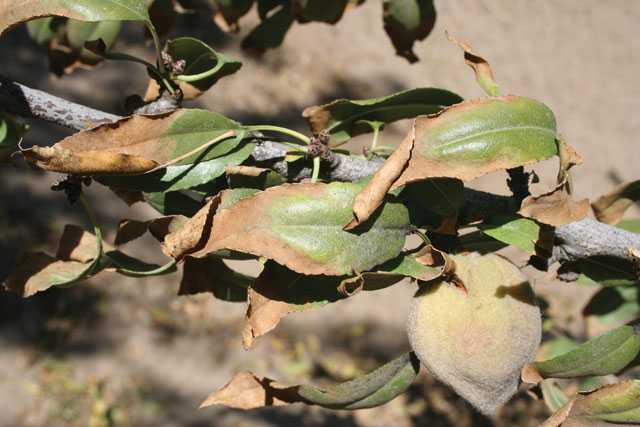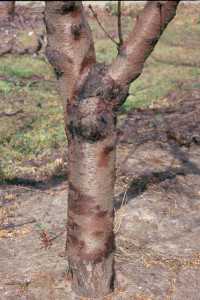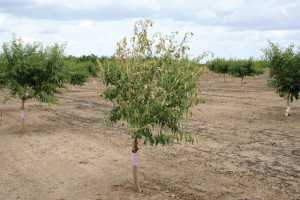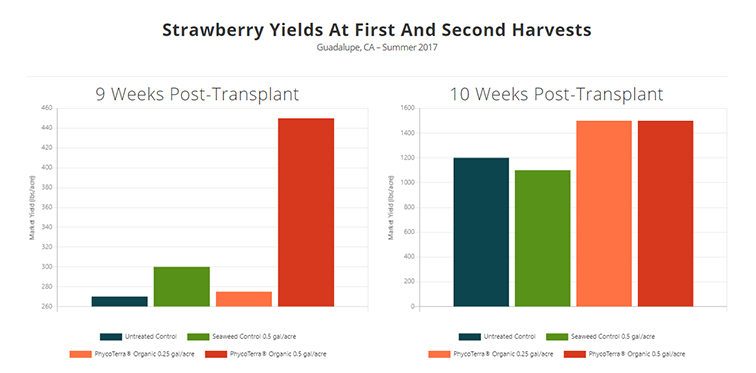How To Choose Almond Rootstocks

Trials in Stanislaus County indicate that Lovell may show signficantly more verticillium wilt symptoms than other rootstocks. This photo shows verticillium wilt symptoms on second-leaf Nonpareil on Lovell. (Photo credit: Roger Duncan)
Like hamburgers, almond trees can be served your way. Growers have the option of special ordering their trees with the variety they want and the rootstock they need. Unfortunately, many almond growers just order “the usual” without studying the menu.
Nemaguard is vigorous, immune to rootknot nematode, compatible with all commercial almond varieties, doesn’t sucker much, has decent anchorage, and growers are familiar with it. However, there are many situations in which Nemaguard struggles or just may not be the best choice. As we continue to replant back into old orchard ground, it may be a good idea to rotate to a different rootstock to lessen the effects of replant problems.
Nemaguard is prone to lime-induced chlorosis (yellowing/iron deficiency) in alkaline soils. It is also susceptible to salt toxicity (sodium, chloride, and boron), asphyxia from saturated soils, Phytophthora root rot, oak root fungus, crown gall, and “heart rot” from various wood decay fungi. Despite the name “Nemaguard,” this rootstock is susceptible to ring and root lesion nematodes. The susceptibility to ring nematode leads to the risk of bacterial canker in second-generation orchards replanted into sandy soil. Lovell may be slightly better in clay loam soils, but it has all the other drawbacks of Nemaguard plus more crown gall, and is highly susceptible to rootknot nematode.
Check Out Hybrids
Over the past 20 years, several hybrid rootstocks have become commercially available in California and are gaining in popularity. These include peach x almond, peach x plum, and other more complex hybrid rootstocks. The best known peach x almond (PxA) hybrid rootstock in California is Hansen, a product of the University of California (UC) breeding program. Another UC PxA hybrid, Nickels, is superior to Hansen but is more difficult to find.
Commercial nurseries also sell their own proprietary PxA rootstocks. There are subtle differences among these PxA hybrids, but as a group they are very vigorous and are the most tolerant rootstocks to alkaline and saline soils. On the negative side, they tend to be very susceptible to root diseases, including Phytophthora, crown gall, and Armillaria (oak root fungus). Most are also highly susceptible to ring nematode and therefore bacterial canker.
In the Sacramento Valley, where soils are often heavier and annual rainfall totals can be three to six times what falls in the San Joaquin Valley, the almond industry is quickly converting to Krymsk 86, a peach x plum hybrid originally from Russia. Although widespread commercial experience with this rootstock is still limited, so far this rootstock has performed well in these conditions. Krymsk 86 appears to have superior anchorage compared to Nemaguard and Lovell. Krymsk 86 also appears to perform well in heavy soils and is as tolerant to Phytophthora as Marianna 2624. It may be less suitable for sandy soils where rootknot nematodes are present. Krymsk 86 is a little less vigorous than Nemaguard and may lend to slightly tighter spacing.

Viking is easily the best rootstock choice for sites prone to bacterial canker (shown here oozing through bark). (Photo credit: Roger Duncan)
Viking And Atlas
Another rootstock gaining in popularity is Viking, a complex hybrid of peach, almond, plum, and apricot. Viking appears to have all the best attributes of Nemaguard but has fewer weaknesses. Like Nemaguard, Viking is well adapted to well-drained loam and sandy loam soil. Viking is slightly more vigorous than Nemaguard and is also immune to rootknot nematode. Viking rarely suckers, appears to have better anchorage than Nemaguard, and is apparently compatible with all commercial almond varieties. In addition, Viking is more tolerant of alkaline soils than Nemaguard and Lovell and is also tolerant of ring nematode. The largest problem we have noticed with Viking is its sensitivity to dehydration during handling at the nursery and at planting. This has occasionally resulted in new trees failing to push after planting.
We are currently monitoring other rootstocks in UC field trials to determine their potential fit in our production system. Empyrean 1 (also known as Barrier 1) has vigor similar to PxA hybrid rootstocks but without many of the disease problems. It also appears to be somewhat tolerant of alkaline soils and maybe ring nematode, but our experience is still very limited.
Atlas is another rootstock of interest. It is a complex hybrid similar to Viking, but the horticultural characteristics are different. Atlas is more susceptible to ring nematode and alkaline soils than Viking but it appears to have better yield efficiency than other rootstocks tested and appears to be more tolerant of alkaline soil than Nemaguard.
Special Challenges

Nemaguard is a popular rootstock among growers, but it is susceptible to salt toxicity as well as several rots and diseases. (Photo credit: Roger Duncan)
While there is no such thing as the perfect rootstock, there are better choices than Nemaguard or Lovell where chemical or biological soil problems exist. Below are some suggestions for specific challenging situations based on UC field trials and observations.
- Heavy Soil/Poor Drainage — As a group, plum rootstocks are pretty tolerant to heavy soil. Marianna 2624 has traditionally been the rootstock of last resort in this situation, but it is considered incompatible with Nonpareil and marginally compatible with Butte. Marianna 2624 also produces a very small tree that suckers profusely and is highly susceptible to ring nematode and bacterial canker.
- Phytophthora — Another Marianna rootstock called M-40 is as tolerant to Phytophthora as M 2624 but is more vigorous and doesn’t sucker any more than Nemaguard. However, it is also incompatible with Nonpareil. M-40 is a more “grower friendly” rootstock than M-2624 but its tolerance to oak root fungus has not yet been proven. Krymsk 86 has also shown resistance to some species of Phytophthora. Several almond varieties, including Nonpareil, have performed well on Krymsk 86 in UC rootstock trials.
- Alkaline Soils/Poor Water Quality — As of today, there are probably no rootstocks better than the PxA hybrids for alkaline and saline conditions. This group includes Hansen, Nickels, Bright’s, Cornerstone, Paramount, and Titan hybrid. Atlas and Viking are more tolerant to alkaline/saline conditions than Nemaguard and Lovell but less than the PxA hybrid rootstocks. However, they may handle heavy soil and most root diseases better than the PxA hybrids so they may be better choices in some areas. Viking appears to be more tolerant to sodium than Atlas. Although Krymsk 86 has been shown in European trials to perform well in alkaline soils, it has not yet been adequately tested in California under these conditions. Preliminary results indicate that Empyrean 1 may also be a good choice in alkaline/saline soil, but more study is needed.
- Bacterial Canker — Viking is easily the best choice for sites prone to bacterial canker. Lovell is better than Nemaguard but it is highly susceptible to rootknot nematode and crown gall and lacks the vigor of Viking. PxA hybrid rootstocks are very susceptible to bacterial canker and should not be planted in second generation orchards with the potential for ring nematodes.
- Oak Root Fungus (Armillaria mellea) — Marianna 2624 plum rootstock is still the only almond rootstock shown to be tolerant of oak root fungus in California at this time, but we are working on it.
- Anchorage — PxA hybrid rootstocks appear to have better anchorage than Nemaguard or Lovell. In the spring of 2001, a rootstock trial conducted by former Kern County farm advisor Mario Viveros was subjected to a fierce Santa Ana wind storm where winds blew more than 75 miles per hour for five hours, along with 1.75 inches of rain. In those five hours, 58% of the sixth-leaf almond trees on Nemaguard blew over. In contrast, only 13% of the trees on Bright’s hybrid, 9% on Hansen, and 4% on Viking were lost. Growers in the Sacramento Valley have stated that Krymsk 86 has superior anchorage to Lovell and this has spurred a tremendous increase in the planting of this rootstock in that area.
- Verticillium Wilt — In a new trial located on the west side of Stanislaus County, Lovell and Paramount, a new PxA hybrid, have shown significantly more wilt symptoms than any of the other 14 rootstocks in the field experiment. Atlas, Viking, Krymsk 86, Hansen, Bright’s #5, and three other PxA hybrids have shown no signs of verticillium so far.
Canopy’s The Key
When it comes to rootstocks, growers need to keep in mind that most vigorous is not necessarily the best. Don’t assume that planting the most vigorous rootstock will automatically lead to the biggest yields.
Comparable yields can be obtained with moderately vigorous rootstocks by planting them a little more densely. The secret to high yields is filling the orchard with canopy. Weak areas and missing trees reduce the yield potential of your orchard. Choosing the appropriate rootstock will go a long way toward reducing the number of weak spots in your orchard and maximizing your yield.
Weigh Your Options
The chart below highlights some of the strengths and weaknesses of different almond rootstocks. While there is no such thing as the perfect rootstock, growers should strive to match them to their orchard’s specific conditions.
| Rootstock | Pros | Cons |
|---|---|---|
| Nemaguard | Vigorous; immune to rootknot nematode; compatible; little suckering; good anchorage | Prone to chlorosis; susceptible to salt toxicity, Phytophthora, crown gall, and ring and root lesion nematodes |
| Lovell | Performs well in clay loam soils | Highly susceptible to crown gall, rootknot nematode, and verticillium wilt |
| Krymsk | Superior anchorage; performs well in heavy soils; tolerant to Phytophthora | Less suitable for sandy soils; less vigorous than Nemaguard |
| Viking | Well adapted to loam and sandy loam soils; immune to rootknot nematode; compatible; tolerant to alkaline soils | Sensitivity to dehydration during handling |
| Atlas | Good yield efficiency; tolerant of alkaline soils | Susceptible to ring nematode |
| Marianna 2624 | Tolerant of heavy soil | Small tree; suckering; susceptible to ring nematode and bacterial canker |
| Marianna 40 | Grower friendly; tolerant to Phytophthora; vigorous | Incompatible with Nonpareil |










